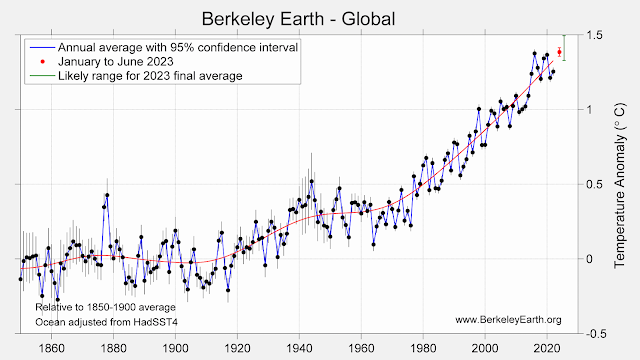Climate in 2023: A Mid-Year Update
We're now just past half way through 2023. At the beginning of the year, it was expected that there was a good likelihood that we would transition into El Niño conditions sometime in the Spring or Summer, and this might lead to a new record high GMST in 2024, with a small chance of this happening in 2023. However, with developments occurring over the last couple months, all that has changed. On Twitter, Zeke Hausfather provided data from Berkeley Earth that, barring some event like a large volcanic eruption, there is an 81% chance that 2023 would beat out 2016/2020 as the warmest year on record. In fact, the year-to-date average already surpasses 2020, and there's a small potential that this year could be the first year to hit the +1.5°C above the 1850-1900 mean.
Hitting 1.5°C would not mean that we have missed the IPCC target of 1.5°C, since that target is built on the 30-year average, not a single year. But what changed from the beginning of the year that would cause such a significant revision upwards of the projected anomaly for 2023? For the answer, we need to begin by looking at the extraordinary events that have taken place in the oceans. As you can see in the preliminary reanalysis data above, some time in mid-March, as El Niño conditions began to form, global SSTs moved into record territory, and since April, the global average for SSTs have been in the neighborhood of 4σ above the 1982-2011 mean. There has been speculation about what factors were involved in causing this, since currently temperatures are significantly warmer than previous daily record temperatures, and they have consistently stayed this way into July. Some have tried to blame this on new shipping emission regulations designed to reduce air pollution. The thought is that the decrease in aerosol pollution might be demasking some of the warming from our greenhouse gas emissions, and this demasking effect might explain the current extreme temperatures. However, currently it looks like the effect of these regulations, while relevant, are also small.
But predictably, GMST temperatures began to spike, as we can see in June 2023, which was by far the warmest June on record. June 2023 was about 0.16°C warmer than the previous record June.

.png)

.png)




Comments
Post a Comment